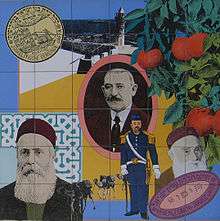David Tartakover
| David Tartakover דוד טרטקובר | |
|---|---|
 | |
| Born | 1944 |
| Nationality | Israeli |
| Education |
Bezalel Academy of Arts and Design London College of Printing |
| Known for | Graphic design, printmaking |

David Tartakover (דוד טרטקובר) (born 1944) is an Israeli graphic designer, political activist, artist and design educator.
He studied at the Bezalel Academy of Arts and Design, Jerusalem, and is a graduate of the London College of Printing. Since 1975, he has operated his own studio in Tel Aviv, specializing in various aspects of visual communications, with particular emphasis on culture and politics.
From 1976, Tatakover has been a senior lecturer in the Visual Communication Department of the Bezalel Academy, is a member of Alliance Graphique Internationale (AGI), has been a president of the Graphic Designers Association of Israel (GDAI).
He has established a reputation for a series of politically provocative self-produced posters, some at the time of Rosh Hashanah (the Jewish new year). His compositions are driven more by content or themes than by high aesthetics. He has described his work as a "seismograph" and "a way of reacting to events... to alter opinions and attitudes".[1]
Tartakover designed Peace Now's logo in 1978.[2] The logo emerged from a poster created by Tartakover for a mass rally, held in what is now Rabin Square in Tel Aviv on April 1, 1978, titled "Peace Now."[2] It became the name of the organization, the first political bumper sticker in Israel[3][4] and it is still one of Israel's most popular stickers.[2] Tartakover, commenting in 2006, said "The movement activists liked the logo, [b]ut they thought there should also be a symbol. I told them it wasn't needed - this is the symbol. It took time until they understood that this was the first political sticker in Israel."[2] The logo combines two typefaces, "Shalom" (peace) in black traditional Koren Bible Type (designed by Eliyahu Koren) and "Achshav" (now) in the red headline-style Haim Type (designed by Jan Le Witt).
He describes himself as "a local designer," meaning that the subjects he tackles concern Israel. He follows the mantra of Hebrew expressionist poet Avigdor Hameiri (b. Andor Feuerstein): "Freedom of opinion is not a right but a duty". Influences on Tartakover's work stem from Gustav Klutsis, John Heartfield, Alexander Rodchenko, Ben Shahn, and Andy Warhol. He claims that his mentor has been comic-book artist Bob Gill and that best work is the Hebrew-lettered "Peace Now" logo. Tatakover is one of the most prominent Israeli graphic designers; others include Franz Kraus (1905–1998), Gabriel and Maxim Shamir (1909–1992, 1910–1990), and Dan Reisinger (b. 1934).
One-Person Exhibitions
Tokyo Designers Space Open Gallery (1982); "Produce of Israel" (1984), Israel Museum, Jerusalem; "Produce of Israel" (1985), Tel Aviv Museum of Art; "Proclamation of the Independence" (1988), Israel Museum, Jerusalem; Espace Floréal, Paris, France (1994); Festival d'affiches, Chaumont, France (1995); Plakatmuseum an Niederrheim, Germany (1997); Passage de Retz, Paris, France (1998); DDD Gallery, Osaka, Japan (1998); Arc en Rêve, Centre d'architecture, Bordeaux, France (1998), Les Rencontres d'Arles festival, France, 2005.
Awards
In 2002, Tartakover was awarded the Israel Prize, for design.[5][6][7] The judges said, "His unique work creates a synthesis between popular and high culture, between the written text and visual imagery, and between personal statements and collective representations of local cultural values. As a creator, teacher, and an active member of the community for over thirty years, he has influenced the language of visual representation in Israel."[8][5]
His work has won numerous awards and prizes and is included in the collections of museums in Europe, U.S. and Japan.
Prizes include the Gold medal, 8th Poster Biennale (1989), Lahti, Finland; second prize at the Salon of Photography (1990), Kalish, Poland; honourable mention, Helsinki International Poster Biennale (1997); bronze medal, 17th International Poster Biennale (2000), Warsaw; second prize, 13th International Poster Biennale (2001), Lahti, Finland
- Sandberg Prize recipient
References
- ↑ Noble, Ian (2002). Up Against the Wall: International Poster Design. Rockport Publishers. p. 8. ISBN 978-2-88046-561-2.
- 1 2 3 4 Becher, Nir (2006-04-27). "Peace Now". Haaretz. Retrieved 10 April 2011.
- ↑ Bloch, L. R. (June 2000). "Mobile discourse: political bumper stickers as a communication event in Israel". Journal of Communication. 50 (2): 48–76. doi:10.1111/j.1460-2466.2000.tb02841.x.
- ↑ Salamon, Hagar (June 2000). "Political Bumper Stickers in Contemporary Israel: Folklore as an Emotional Battleground". The Journal of American Folklore. 114 (453): 277–308. doi:10.1353/jaf.2001.0020.
- 1 2 Zandberg, Esther (2002-02-02). "Israel Prized to Ran Carmi and David Tartakover". Haaretz. Retrieved 10 April 2011.
- ↑ "Israel Prize Official Site (in Hebrew) – Recipient’s C.V.". Archived from the original on 2009-10-19.
- ↑ "Israel Prize Official Site (in Hebrew) – Judges' Rationale for Grant to Recipient". Archived from the original on 2009-10-19.
- ↑ Joel Beinin, Rebecca L. Stein, ed. (2006). "21. The Art of Dissent. David Tartakover". The struggle for sovereignty: Palestine and Israel, 1993-2005. Stanford University Press. pp. 214–218. ISBN 978-0-8047-5365-4.
Further reading
- Goldstaub-Dainotto, Edna (1997), "David Tartakover: the imagery of hope." Graphis magazine (vol. 53, pp. 50–57)
See also
External links
- Official website
- David Tartakover - The Palestine Poster Project Archives
- David Tartakover:Freehand Design / Motto of My Work - Posters of Discontent exhibit
- I Am Here - The Israeli Center for Digital Art
- I Am Here - International Triennale of Political Posters, Mons, Belgium, 2004